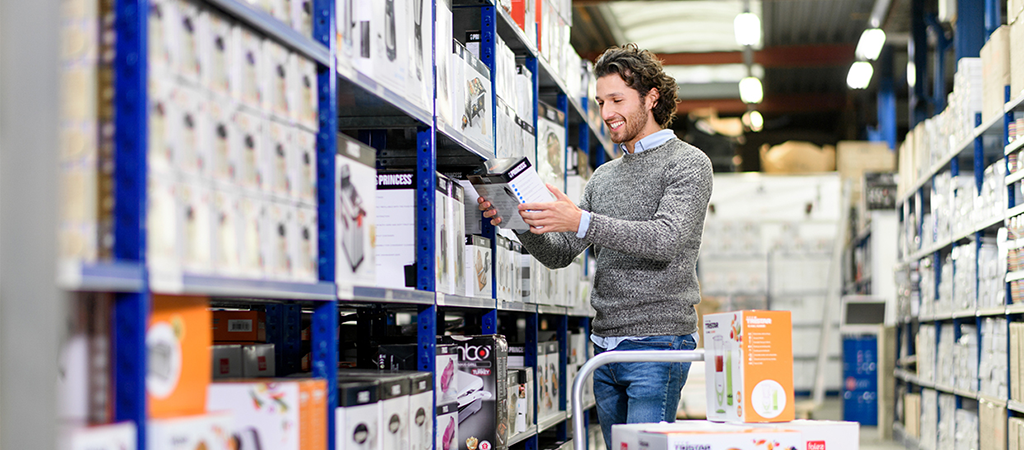As a growing e-commerce business owner, you know that e-commerce logistics is the backbone of your business success. From ensuring customer satisfaction to improving your profit margins, it’s all about getting your products from your warehouse to your customers. And that’s where having the right e-commerce logistics strategy comes in.
In this article, we’re going to share with you the essential strategies you need to optimise your e-commerce logistics to take your business to the next level.
But first, let’s answer the most basic question – what exactly is e-commerce logistics?
What is e-commerce logistics?
We could tell you that it’s the process of getting your products from point A to point B, but that would be a gross oversimplification.
E-commerce logistics is the foundation of your business, and it encompasses everything from picking and packing to shipping and delivery, and even returns.
If you’re like most e-commerce business owners, you know that there are many components to a successful logistics strategy. That’s why we’re going to break it down for you, step by step.
In this article, we’ll cover the five key parts of a successful e-commerce logistics journey, and give you the tools you need to optimise each and every step of the way. So sit back, grab a cup of coffee, and let’s dive into the wonderful world of e-commerce logistics!
The 5 key parts to e-commerce logistics:
1: Inventory management: Maintain the right level of stock
Naturally, the first step in the e-commerce logistics journey is your stock. And that’s where inventory management comes into play as it is critical to ensure that you have enough stock to fulfil orders without overstocking.
Let’s say you run a small online store that sells handmade jewellery. Your business has been growing steadily, but you’re finding it increasingly challenging to manage your inventory levels. Sometimes you have too much stock of one item and not enough of another, which can lead to lost sales and wasted money.
To improve your inventory management, consider implementing the following strategies:
- Use a forecasting tool: You start using a tool that analyses your sales data to predict future demand for each item. Based on this information, you adjust your inventory levels accordingly. This helps you avoid overstocking or understocking, which can lead to lost sales and unhappy customers.
- Set up automatic reorder points: You set up a system that automatically reorders items when they reach a certain threshold. This ensures that you always have enough stock on hand to fulfil customer orders without having to constantly monitor inventory levels.
- Utilise an inventory management system: You invest in an inventory management system that helps you track stock levels accurately and streamline your inventory operations. With this system, you can easily see which items are selling well and which ones aren’t, and make informed decisions about which products to stock more of and which ones to discontinue.
By implementing these strategies, you will be able to maintain the right level of stock for your business, avoid stockouts and overstocking, and improve your overall inventory management processes.
2: Warehousing: Manage your products for efficient e-commerce logistics
Making sure your e-commerce logistics runs smoothly isn’t just about checking you have the right amount of stock for when, but also how you run and optimise your warehousing.
Poor warehouse management can become a huge cost on your business, increasing the risk of the wrong items being shipped, damaged goods, and delays in fulfilling orders. But when your warehouse is running smoothly, it becomes the beating heart of all your operations.
Here are some strategies you can use to improve your warehouse management:
- Choose a warehouse location that is centrally located and has easy access to transportation networks for faster delivery.
- Use a warehouse management system to monitor inventory levels, track the location of products, and automate processes to streamline warehouse operations.
- Ensure that the warehouse meets all safety and security standards, including security cameras and proper lighting, to prevent theft and damage to products.
- Regularly maintain and organise the warehouse to optimise the use of space, reduce errors, and increase efficiency.
Read more top tips on how to reduce shipping costs with warehouse management and more in our full article.
3: Order management: streamline your order fulfilment process
Now this is where things really get serious. The order management process is naturally a fundamental part to your e-commerce logistics as it is the picking, packing and dispatching of your orders.
In the world of Amazon, same-day dispatch and next day delivery, this means your order processing needs to be fast and accurate. Automating the order fulfilment process is key to achieve this.
Benefits to automating your e-commerce logistics include:
- Faster order fulfilment: Process orders more quickly, reducing the time between order placement and delivery.
- Improved accuracy: Automation reduces the likelihood of human error, resulting in more accurate order processing and a lower rate of returns.
- Increased efficiency: Automated order processing eliminates manual tasks and reduces the risk of delays or bottlenecks in the order fulfilment process.
- Enhanced customer satisfaction: Customers expect fast and accurate order delivery, and automation can help meet those expectations, resulting in higher customer satisfaction.
- Greater scalability: As you grow, manual order processing will become overloaded, making it difficult to keep up with demand. Automated order processing will help you scale operations without sacrificing order accuracy or fulfilment speed.
- Cost savings: By reducing manual labour and improving efficiency, you can save on labour costs and reduce the risk of errors.
The Sweetie Shoppie, a dynamic e-commerce store, was facing numerous hurdles in their order processing. “We were stuck with an outdated and cumbersome system. Measuring each package with a ruler and entering the dimensions and weight manually was a nightmare!“ exclaimed the team.
But, with the implementation of cutting-edge automation, The Sweetie Shoppie has revolutionised their order processing. “Now, packing and dispatching packages is a breeze! We simply print off the packing slips, grab them from the printer, and voila – our packing table is ready for action! No more manual measurements or inputting data for each package.“
The new automated system has even allowed The Sweetie Shoppie to save big on shipping costs. “With the diverse range of packages we ship, costs would get high when we shipped large or heavy packages. But, thanks to Sendcloud, we get all parcels up to 15kg at a flat rate. This means there are no more budget surprises when the invoice arrives!“

4: Shipping and delivery: provide fast and reliable e-commerce logistics
The delivery is the final step in getting your products to your customers. So naturally it is highly important.
But in this time, delivery is no longer just about the physical act of getting the packages to their destinations. The delivery options you offer to your customers are now essential to your conversion and customer retention rates.
Optimising your shipping strategy won’t just make things simpler for you, but will also help to meet the high expectations customers now have when it comes to delivery.
Strategies to improve your shipping and delivery process include:
- Offer multiple shipping options, including express delivery, to meet customer expectations
- For example, Sendcloud can help you offer multiple carriers and shipping methods in your checkout. For example, offer customers both next-day delivery and delivery to a pick-up point alongside your standard shipping to improve the delivery times and customer satisfaction.
- Use a shipping management system to automate shipping processes and track shipments
- Using a system like Sendcloud allows you to streamline your shipping processes, generate shipping labels, and automatically update tracking information for your customers.
- Provide customers with tracking information so they can monitor their orders
- Sendcloud automatically sends tracking information to your customers via email or text message, allowing them to monitor their orders and reduce customer inquiries.
If you want more insights on what customers want with their delivery, and how it can affect your business’s conversion rates, be sure to check out the E-commerce Delivery Compass.
5: Returns management: Provide hassle-free returns
You may have thought you were finished after the products were shipped, but returns management is a critical aspect of e-commerce logistics that should not be forgotten.
Ensuring that you have a clear and easy-to-understand returns policy in place will make the process hassle-free for customers. And that may seem counter-productive, but a hassle-free process will only work to improve your customer retention rate, building your customers’ confidence in your store and encouraging them to shop with you again.
Some strategies to improve your returns management include:
- Offer a simple and straightforward returns policy with clear instructions on how to initiate a return
- Use a returns management system to automate the returns process and track returned items
- Regularly analyse returns data to identify patterns and improve your products and services
To eliminate a complicated and time-consuming return process, look for a quality return management solution. Dreaminzzz, a customer of Sendcloud, integrated our returns portal and have seen a significant improvement in their customer satisfaction levels.
“The Sendcloud return portal is a great help to us and makes our customer service very professional. In the case of exchange or refund, we simply send the portal link to the customer, who then edits their own label (pre-paid). It’s a big time saver for us and a huge plus for the customer.”
E-commerce logistics conclusion
Don’t let poor logistics be the reason your e-commerce business struggles to take off. With Sendcloud, you can take control of your supply chain and streamline your operations for maximum efficiency.
By implementing our proven strategies, you can increase customer satisfaction, boost sales, and watch your business thrive like never before.
So why wait? Get in touch with us today to learn more about how Sendcloud can help you take your e-commerce logistics to the next level. Let’s build a brighter future for your business, together.
















